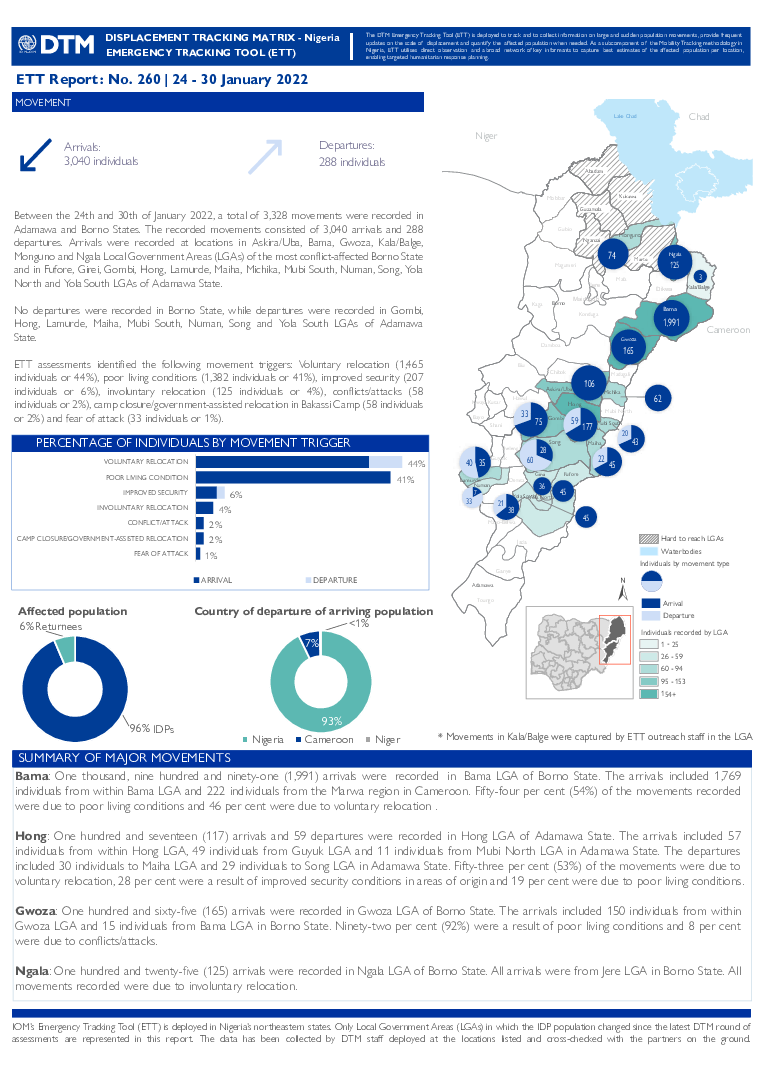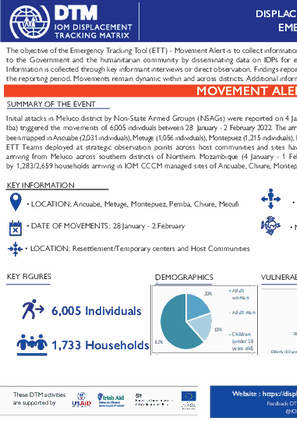-
Countries
-
Data and Analysis
-
Special Focus
-
Crisis Responses

Contact
DTM Nigeria, AllUsersInDTMNigeria@iom.int
Language
English
Location
Nigeria
Period Covered
Jan 24 2022
Jan 30 2022
Activity
- Event Tracking
- Mobility Tracking
Between the 24th and 30th of January 2022, a total of 3,328 movements were recorded in Adamawa and Borno States. The recorded movements consisted of 3,040 arrivals and 288 departures. Arrivals were recorded at locations in Askira/Uba, Bama, Gwoza, Kala/Balge, Monguno and Ngala Local Government Areas (LGAs) of the most conflict-affected Borno State and in Fufore, Girei, Gombi, Hong, Lamurde, Maiha, Michika, Mubi South, Numan, Song, Yola North and Yola South LGAs of Adamawa State.
No departures were recorded in Borno State, while departures were recorded in Gombi, Hong, Lamurde, Maiha, Mubi South, Numan, Song and Yola South LGAs of Adamawa.
State.

Contact
DTM Pakistan, iomisbdtmremapteam@iom.int dtmremapsupport@iom.int
Language
English
Location
Pakistan
Period Covered
Oct 01 2021
Dec 31 2021
Activity
- Flow Monitoring
IOM Pakistan collects data on the outflows of undocumented Afghan migrants at the Torkham and Chaman border crossing points in an effort to better understand the migration movements of undocumented Afghan migrants returning to Afghanistan from Pakistan. This report is part of the European Union funded project ‘‘Displacement Tracking Matrix Regional Evidence for Migration Analysis and Policy (DTM REMAP)”. Key findings during this reporting period are:
- From October to December 2021, 16,398 undocumented Afghan migrants spontaneously returned to Afghanistan, including 2,874 through the Torkham border point and 13,524 through the Chaman border point.
- Among the total number of undocumented Afghan returnees, border authorities facilitated the return of 72 individuals due to the lack of legal documentation to remain in Pakistan. Therefore, information concerning these 72 individuals is not included in the report analysis.
- The average family size of returnees was 10 individuals and 12% of all returnees recorded during the reporting period were categorized as vulnerable persons.
- All returnees were carrying household items, personal belongings and cash when surveyed. They also travelled with additional items, such as productive assets (99%), transportation vehicles (28%) and livestock (3%).
- The top 3 challenges returnees expected to face in Afghanistan were: arranging livelihood, settling into a new city and finding better income opportunities.

Contact
DTM Pakistan, iomisbdtmremapteam@iom.int dtmremapsupport@iom.int
Language
English
Location
Pakistan
Period Covered
Jan 15 2022
Jan 28 2022
Activity
- Flow Monitoring
IOM Pakistan collects data on the outflows of undocumented Afghan migrants at the Torkham and Chaman border crossing points in an effort to better understand the migration movements of undocumented Afghan migrants returning to Afghanistan from Pakistan. This exercise is part of the European Union funded project “Displacement Tracking Matrix Regional Evidence for Migration Analysis and Policy (DTM REMAP)”.
From 15 January to 28 January 2022, 2,488 undocumented Afghan migrants returned to Afghanistan, including 269 through the Torkham border point and 2,219 through the Chaman border point. During the reporting period, border authorities facilitated the return of 101 individuals due to the lack of legal documentation to remain in Pakistan. Therefore, information concerning these 101 individuals is not included in the report analysis.

Contact
DTM Pakistan, iomisbdtmremapteam@iom.int dtmremapsupport@iom.int
Language
English
Location
Pakistan
Period Covered
Jan 01 2022
Feb 14 2022
Activity
- Flow Monitoring
IOM Pakistan collects data on the outflows of undocumented Afghan migrants at the Torkham and Chaman border crossing points in an effort to better understand the migration movements of undocumented Afghan migrants returning to Afghanistan from Pakistan. This exercise is part of the European Union funded project “Displacement Tracking Matrix Regional Evidence for Migration Analysis and Policy (DTM REMAP)”.
From 01 January to 14 January 2021, 2,488 undocumented Afghan migrants returned to Afghanistan, including 139 through the Torkham border point and 2,349 through the Chaman border point. During the reporting period, border authorities facilitated the return of 41 individuals due to the lack of legal documentation to remain in Pakistan. Therefore, information concerning these 41 individuals is not included in the report analysis.

Contact
DTMMozambique@iom.int
Language
English
Location
Mozambique
Period Covered
Jan 28 2022
Feb 02 2022
Activity
- Event Tracking
- Mobility Tracking
Initial attacks in Meluco district by Non-State Armed Groups (NSAGs) were reported on 4 January 2022. Recent attacks in Muaguide posto - (Mitemba, Sitate, and Iba) triggered the movements of 6,005 individuals between 28 January - 2 February 2022. The arrival of displaced populations from Meluco within this reporting period have been mapped in Ancuabe (2,031 individuals), Metuge (1,056 individuals), Montepuez (1,215 individuals), Pemba (1,149 individuals), Chiure (547 Individuals), and Mecu (7 individuals). ETT Teams deployed at strategic observation points across host communities and sites have cumulatively observed at least 9,381 individuals/2,659 households arriving from Meluco across southern districts of Northern Mozambique (4 January - 1 February).

Contact
DTMMozambique@iom.int
Language
English
Location
Mozambique
Period Covered
Jan 26 2022
Feb 01 2022
Activity
- Event Tracking
- Mobility Tracking
During the reporting period (26 January to 1st February 2022), a total of 54 movements were recorded - 49 Arrivals (5,506 individuals), and 5 departures (306 individuals). The largest arrival movements were recorded in Ancuabe (2,093 individuals), Montepuez (1,158 individuals), Cidade de Pemba (667 individuals), Chiure (547 individuals), Nangade (457 individuals), Metuge (369 individuals) and Mueda (206 individuals). The largest departure was observed in Montepuez (265 individuals). Of the total population captured by the ETT, 90 per cent were displaced for the first time, and 10 per cent of reported IDPs had been displaced more than once prior to this latest movement.
Contact
DTM Niger Location
Niger
Activity
- Mobility Tracking
- Baseline Assessment
Period Covered
Dec 04 2019 -Dec 17 2019
A baseline assessment is a sub-component of mobility tracking. It aims to collect data on IDP, migrant or returnee population presence in a defined administrative area of the country.
Population Groups
Survey Methodology
Unit of Analysis Or Observation
Type of Survey or Assessment
Keywords
Geographical Scope
Administrative boundaries with available data
The current dataset covers the following administrative boundaries
Contact
DTMDRC@iom.int
Location
Democratic Republic of the Congo
Activity
- Mobility Tracking
- Baseline Assessment
Period Covered
Aug 03 2021 -Aug 23 2021
A baseline assessment is a sub-component of mobility tracking. It aims to collect data on IDP, migrant or returnee population presence in a defined administrative area of the country.
Population Groups
Survey Methodology
Unit of Analysis Or Observation
Type of Survey or Assessment
Keywords
Geographical Scope
Administrative boundaries with available data
The current dataset covers the following administrative boundaries

Contact
DTM Mozambique, DTMMozambique@iom.int
Language
English
Location
Mozambique
Period Covered
Jan 25 2022
Jan 31 2022
Activity
- Event Tracking
- Mobility Tracking
Following these events, rapid assessments were conducted by the International Organization for Migration (IOM) in collaboration with the National Institute for Disaster Management and Risk Reduction (INGD), from the 25 January 2022. Rapid assessments are still ongoing with a focus on understanding the extent of initial displacements across accommodation centers and hosting communities as well as damages to houses and facilities across all affected localities in Tete, Niassa, Sofala, Nampula and Zambezia Provinces.
As a result of the impact of Tropical Storm Ana, an estimate of 42,800 families had their houses completely/partially destroyed in the districts assessed so far. Of these 80% are in Nampula (34,244 houses), 15% in Zambezia (6,488 houses), 2% in Tete (812 houses) and 3% in Sofala (1,256). In addition, 21 tents and 16 emergency shelters were completely or partially destroyed due to the rain and strong winds.
IOM/INGD identified 409 latrines and 8 water points damaged. Moreover, localities assessed so far identified at least 98 schools reporting partial and major damaged. Affected schools are in Nampula (62), Zambezia (29), Sofala (7) provinces. A total of 259 classrooms were completely or partially damaged in the affected schools.
In assessed locations, 16 health centres were also completely/partially damaged in Nampula (14) and Zambezia (2)

Contact
DTM Afghanistan, DTMKabul@iom.int
Language
English
Location
Afghanistan
Period Covered
Dec 01 2021
Dec 19 2021
Activity
- Event Tracking
IOM Afghanistan identified 93,631 internally displaced persons (IDPs) who were displaced to or arrived in Kabul province since August 2021 during Round 3 of the Emergency Event Tracking (EET) exercise. Most IDPs arrived in urban communities (82%), while the remaining are displaced in rural (14%) and peri-urban (3%) communities throughout Kabul province.
From 1 to 19 December 2021, DTM teams conducted Round 31 of the EET to capture movement dynamics in Afghanistan following episodes of drought and rapid political transformations that occurred in 2021. During Round 3, DTM teams assessed 550 communities in 15 districts in Kabul province. The data presented in the report is a snapshot of the current displacement situation from the above-mentioned observation period and provides the latest and best available information from EET sources up until 19 December 2021.